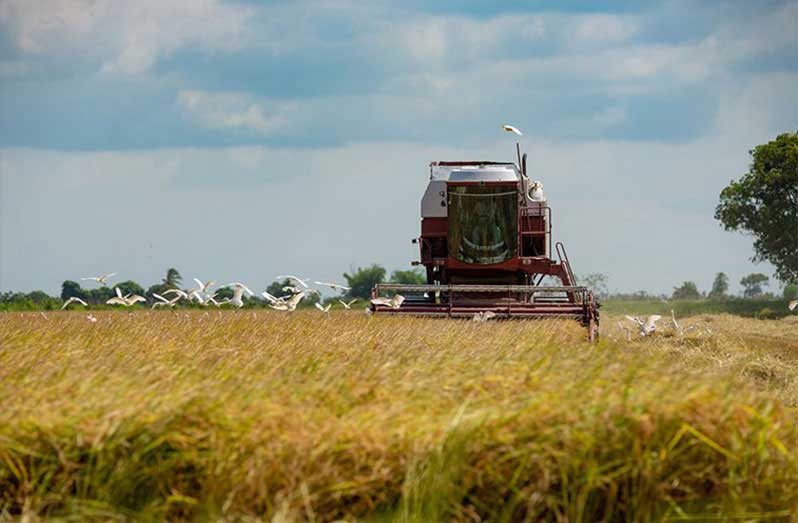–Agriculture Minister discloses, says over 700,000 tonnes of rice produced
–over US$245M earned from export of this commodity, byproducts
GUYANA’S rice industry has seen significant growth, with ‘record high’ production reaching 725,282 tonnes in 2024, Agriculture Minister Zulfikar Mustapha has said.
At a year-end press conference on Monday, Mustapha told reporters that this improved output reflects direct policies and investments made by the government to ensure that the country remains competitive on the world market.
“This is a record-breaking production,” the Agriculture Minister boasted.
The ministry increased its yield from 5.7 tonnes in 2020 to 6.6 tonnes per hectare in 2024 for the last four years.
This incremental increase in rice production has been ongoing since 2021, when production was at 559,789 tonnes. In 2022, it increased to 610,595 tonnes, and 653,706 tonnes in 2023.
Mustapha said: “Since the introduction of rice production in our country, we have surpassed the 700,000 tonnes, with an average national yield of 6.6 tonnes per hectare, the highest ever recorded in the country’s history.”
Meanwhile, the country exported 425,490 tonnes of rice and byproducts to 30 countries at a value of over US$245,000,000.
According to Mustapha, new markets were also unlocked with Guyana now supplying rice to Africa, and retaining other markets within the Caribbean and across the region.
GOVERNMENT ASSISTANCE
Crediting the massive production boost to the local farmers, Mustapha highlighted that the government has been able to offer assistance through training and providing inputs.
He pointed out that the government was able to settle the former A Partnership for National Unity +Alliance for Change (APNU+AFC) administration’s mismanagement of the rice sector, which saw several rice farmers and millers being owed billions by Panama and Venezuela for rice that was exported back in 2015.
For the Panamanian market, the farmers were owed $1.5 billion, he said, adding that this had put a strain on several rice millers, who had later gone bankrupt.
Earlier this year, the government was able to negotiate with Panama, and after several years, 17 rice millers received the money that was owed them.
Another 27 rice farmers and five millers recently received their payments that were owed them by Venezuela and Panama in 2015, totalling $437 million at the weekend. He noted that these farmers had waited nine years to receive their payments.
Outside of this, Mustapha further pointed out that farmers benefitted from decreased land rentals and drainage and irrigation charges.
Further support in providing fertiliser, pesticide and other inputs amounted to $1.8 billion.
In addition to this, just over 5,000 rice farmers received training from the Guyana Rice Development Board (GRDB), covering a series of topics such as disease, pest control and crop management.
Another 1,046 farmers, who were found to have low yields, were grouped into a specialised programme aimed at boosting production.
Mustapha believes that it is due to these policies that the local rice industry has flourished over the past year.
He said: “In the rice industry, we have seen tremendous improvement; tremendous improvement this year. I want to say that I’m very proud that we have reached that level of production in rice.”
NEW VARIATIES
Meanwhile, to further advance rice production, Guyana, in the past four years, has been exploring new rice varieties to increase productivity, and enhance resilience to climate change.
This initiative, led by the GRDB, Mustapha said, had seen extensive research into varieties that offer higher yields, better disease resistance, and higher nutritional values.
“For this year, 2024, we have developed a new variety, GRDB18, with a yield potential of seven to nine tonnes per hectare. This was launched in October of 2024. Since 2020, we have released three new varieties, GRDB 16, GRDB 18, and the biofortified zinc-infused GRDB17, which all have yield potential of between seven to nine tonnes per hectare,” Mustapha said.
The GRDB 17 was developed through conventional farming practices, without genetic modification, as rice naturally accumulates higher levels of zinc than usual. Zinc is essential for the proper functioning of people’s immune systems, and the fight against infectious diseases such as COVID-19.
The ministry has also seen an increased capacity of its seed paddy facilities at the various locations.
These facilities, located in Regions Five and Six, have the capacity to produce 152,000 bags per annum.



.jpg)











